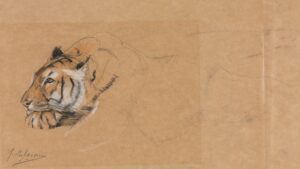Drawing:xms2zhd83gq= Tiger
 Capturing the majestic essence of a tiger on paper is both an exciting and rewarding challenge for artists of all levels. Tigers, with their striking stripes and powerful presence, offer a captivating subject that can enhance any artist’s portfolio. Whether you’re a beginner eager to explore the basics or a seasoned artist looking to refine your skills, understanding the nuances of drawing this magnificent creature can elevate your artistic journey.
Capturing the majestic essence of a tiger on paper is both an exciting and rewarding challenge for artists of all levels. Tigers, with their striking stripes and powerful presence, offer a captivating subject that can enhance any artist’s portfolio. Whether you’re a beginner eager to explore the basics or a seasoned artist looking to refine your skills, understanding the nuances of drawing this magnificent creature can elevate your artistic journey.
The process of drawing a tiger involves more than just replicating its physical features. It requires a keen eye for detail and a deep appreciation for the animal’s grace and strength. By focusing on elements like anatomy, texture, and expression, artists can bring their tiger illustrations to life, capturing the wild beauty that defines these incredible cats. With the right techniques and a bit of practice, anyone can master the art of drawing tigers, creating stunning works that resonate with viewers.
Understanding the Basics of Drawing a Tiger
Drawing a tiger requires a firm grasp of its unique features and patterns. Artists can elevate their work by focusing on foundational elements, ensuring each piece reflects the tiger’s majesty.
Research and Gather References
Accurate depictions begin with thorough research. Artists benefit from studying high-quality images and videos of tigers in various poses and lighting conditions. Authentic sources like wildlife photography websites and documentaries show muscle movement, facial  expressions, and detailed fur patterns. Observational sketches from these references help artists understand the animal’s form and capture its essence.
expressions, and detailed fur patterns. Observational sketches from these references help artists understand the animal’s form and capture its essence.
Effective tools enhance the drawing process. Artists use graphite pencils for accuracy and control, with varying grades for different shading intensities. Erasers aid in refining intricate details like fur and whiskers. Quality paper, such as heavyweight drawing paper, supports detailed work and prevents buckling. Digital artists use drawing tablets and styluses to achieve precision and experiment with textures dynamically.
Sketching the Tiger
Capturing the essence of a tiger in a sketch involves focusing on its unique attributes. Mastering the techniques of sketching enhances the portrayal of its majesty and strength.
Creating the Outline
Artists begin with a light outline to guide the sketch’s composition. Establishing the basic shapes and forms and mapping the tiger’s posture are crucial. Use circles and ovals to represent the head and body positions. Lines mark leg and tail orientation, aiding in the alignment of the various elements. Ensure the outline mirrors a tiger’s dynamic stance, setting the foundation for detail.
Proportions and Anatomy
Understanding a tiger’s proportions and anatomy enhances sketch accuracy. The head typically makes up 1/5 of the body length, so ensure facial features are proportionate. The body’s length and width must balance with its limbs and tail structure. Study muscle and bone placements and observe details in the shoulder and hip areas to depict the tiger’s robust form. This knowledge assists in capturing the realistic portrayal of its powerful physique.
Adding Details and Texture
Adding details and texture transforms a basic tiger sketch into a lifelike masterpiece. Focusing on fur and stripes enhances the  authenticity of the artwork.
authenticity of the artwork.
Drawing fur accurately requires careful observation of texture and direction. Artists must note that tiger fur flows differently around distinct body areas. Short, dense fur appears on the face, with longer strands on the cheeks and around the neck. For the body, artists typically use a combination of short and long strokes to depict the fluffy yet sleek appearance. Graphite pencils or digital brushes with varied pressure sensitivity can mimic this texture, making the fur appear natural and layered.
Tiger stripes are unique and follow specific patterns, contributing greatly to the animal’s identity. These stripes curve and bend along the body’s form, emphasizing its muscular structure. Each stripe should be drawn with precision, contrasting sharply against the lighter fur. Artists may employ a darker pencil grade or a digital tool with opacity settings to create defined lines. Observing references ensures accurate representation, as no two tigers have identical stripe patterns. Properly rendering these markings adds depth and realism to the drawing.



